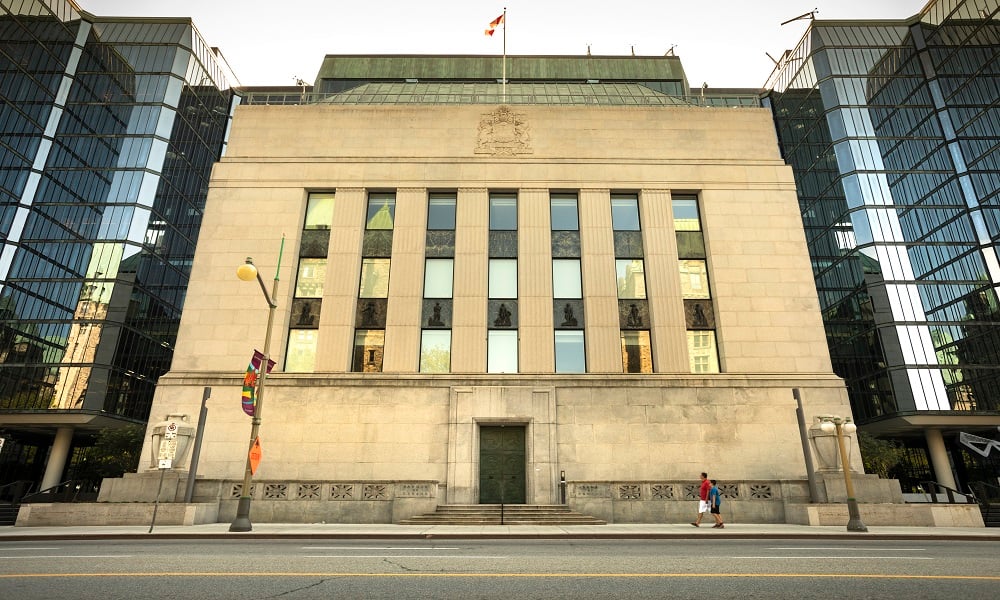Advisors offer their take on central bank's decision to end QE and bring forward timing of first interest-rate hike

Reaction to the Bank of Canada’s announcement was generally favourable yesterday as it maintained its current interest rates – even while signalling higher ones are coming – and said it’s ending quantitative easing. But, advisors watching it closely and are warning others about how they can protect clients in these uncertain times.
“I think it’s a good thing that the Bank has started to end the quantitative easing a little bit,” said Sean Harrell, Partner and Senior Advisor at Howe Harrell & Associates in Winnipeg. “The nice thing about it is that I’ve been watching the markets today (Wednesday). They’re off by only 0.75%, but that’s a good thing. Usually when there’s news about quantitative easing ending, the markets panic a little bit. So, I’m hoping that the markets were ready for this and we can just keep on trucking, like we have after that little COVID pick-up.”
Harrell was a bit more concerned about inflation since the Bank usually raises interest rates to combat it.
“They’re going to leave things as is, so I hope they keep a close eye on that,” he said. “We don’t want inflation to start running rampant and start rising interest rates before the economy is ready and send it back into a tailspin.”
The Bank announced it would maintain its overnight interest rate at .25%, the bank rate at .5%, and the deposit rate at .25% until the economic slack is absorbed and a 2% inflation target could be sustainably achieved, which it expects in mid-2022. It also said it would buy Government of Canada bonds solely to replace maturing bonds as it ends quantitative easing, and it would keep its overall holdings of Canada bonds roughly constant.
The Bank also forecast that the Canadian economy would grow by 5% in 2021 before moderating to 4.25% in 2022 and 3.75% in 2023, even though manufacturing input shortages, transportation bottlenecks, and labour shortages are still limiting its productive capacity. It also projected that global gross domestic product would grow by 6.5% in 2021, which was slightly less than it projected in July, and by 4.25% in 2022 and 3.5% in 2023.
Harrell was optimistic about the economic future, saying, “I really like the balance sheets of the companies that we’re investing in nowadays because those established companies look really strong. I don’t see a reason for them to falter.” He noted larger companies have bought smaller, struggling ones on the fringe and maintained strong balance sheets, but the Bank’s inflation projections also maintain growth without inflation becoming too problematic.
The Bank said it expected the increase in consumer price index (CPI) inflation in July, but now expects it to be elevated into 2022 before easing back to about 2% by late 2022. It is closely watching inflation expectations and labour costs to ensure that temporary forces pushing up prices don’t become embedded in ongoing inflation.
“It will be interesting to find out whether prices will come back down once these bottlenecks start to work themselves out. That’s the main question my clients are asking now,” said Harrell, noting he doesn’t expect things like lumber costs to decrease. “So, make sure your financial plans have good inflation rates incorporated in them,” he warned other advisors, especially if clients will soon make major purchases, such as building a home, which now costs more.
The Conference Board of Canada also weighed in after the announcement. It said supply chain disruptions are here to stay until at least mid-2022, and those are not just fanning inflation, but subduing growth. It added that it expects the Bank to wait until the third quarter of 2022, once economic slack has been eliminated, to raise rates, and it warned it to err on the side of caution since it’s easer for a central bank to lower higher prices than to prop up stalling growth.
Zach Davidson, an investment advisor and portfolio manager at National Bank Financial Wealth Management, was a bit surprised the Bank advanced the timing when it will likely raise rates and now is looking at the first half of 2022.
“I was just chatting with a client and said it’s tough to have it both ways and have ultra-low interest rates and a really strong market and recovering economy that looks to be improving with the unemployment rate going down,” he said. “You can’t have everything, and we’re still at really ultra-low interest rate levels because of the pandemic. It is time for the Bank of Canada to start moving, but we’re still talking 2022. There are no changes this year.”
Davidson has noticed that interest rate uncertainty is impacting clients who must decide between variable and fixed rate mortgages. He recently recommended fixed for a client since rates are expected to rise, but when isn’t known.
“If you can lock in decades of low-interest rates for a mortgage, you get that peace of mind rather than choosing a variable rate and having to be concerned about whether the Bank of Canada is going to raise rates every time it has a press conference,” he said, adding that by the time the Bank raises rates, “it’s going to be the worst-kept secret.”
As for advice for advisors' clients, Davidson said, “stick to your plan. It’s not a time to be making changes and trying to outguess what the Bank of Canada or Fed are going to do. Just have a portfolio that you’re comfortable with, keep focused on the long-term goals and tune out all the noise that’s around portfolios these days. Continue with the great companies and don’t worry as much about monetary policy and what the next change is around the corner.”



